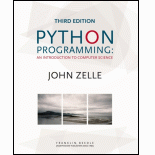
Python Programming: An Introduction to Computer Science
3rd Edition
ISBN: 9781590282779
Author: John Zelle
Publisher: Franklin Beedle & Associates
expand_more
expand_more
format_list_bulleted
Expert Solution & Answer
Chapter 7, Problem 1D
a)
Explanation of Solution
Simple decision:
- In python, decisions can be implemented using “if” statements.
- Python handles the following type of decisions,
- Simple decision
- Two-way decision
- Multi-way decision
- Simple decisions can be implemented by a simple “if” statement.
- Example:
#Initialize the variable
a=1
#Check the condition using “if” statement
if (
b)
Explanation of Solution
Two-way decision:
- In python, decisions can be implemented using “if” statements.
- Python handles the following type of decisions,
- Simple decision
- Two-way decision
- Multi-way decision
- Two-way decisions can be implemented by “if-else” statement.
- Example:
#Initialize the variables
a=5
b=3
#Check the condition using “if” statement
if(a<b):
�...
c)
Explanation of Solution
Multi-way decision:
- In python, decisions can be implemented using “if” statements.
- Python handles the following type of decisions,
- Simple decision
- Two-way decision
- Multi-way decision
- Multi-way decision can be implemented by “if-elif-else”, and nested “if-else” statements.
- Example:
#Initialize the variables
a=5
b=3
c=6
#Check the condition using “if” statement
if(a<b && a<c):
#Print “a” value
print(a)
#Check the condition using “elif” statement
elif(b<c):
Expert Solution & Answer
Want to see the full answer?
Check out a sample textbook solution
Students have asked these similar questions
I want to solve 13.2 using matlab please help
a) Show a possible trace of the OSPF algorithm for computing the routing table in Router 2 forthis network.b) Show the messages used by RIP to compute routing tables.
using r language to answer question 4 Question 4: Obtain a 95% standard normal bootstrap confidence interval, a 95% basic bootstrap confidence interval, and a percentile confidence interval for the ρb12 in Question 3.
Chapter 7 Solutions
Python Programming: An Introduction to Computer Science
Ch. 7 - Prob. 1TFCh. 7 - Prob. 2TFCh. 7 - Prob. 3TFCh. 7 - Prob. 4TFCh. 7 - Prob. 5TFCh. 7 - Prob. 6TFCh. 7 - Prob. 7TFCh. 7 - Prob. 8TFCh. 7 - Prob. 9TFCh. 7 - Prob. 10TF
Ch. 7 - Prob. 1MCCh. 7 - Prob. 2MCCh. 7 - Prob. 3MCCh. 7 - Prob. 4MCCh. 7 - Prob. 5MCCh. 7 - Prob. 6MCCh. 7 - Prob. 7MCCh. 7 - Prob. 8MCCh. 7 - Prob. 9MCCh. 7 - Prob. 10MCCh. 7 - Prob. 1DCh. 7 - Prob. 2DCh. 7 - Prob. 3DCh. 7 - Prob. 1PECh. 7 - Prob. 2PECh. 7 - Prob. 3PECh. 7 - Prob. 4PECh. 7 - Prob. 5PECh. 7 - Prob. 6PECh. 7 - Prob. 7PECh. 7 - Prob. 8PECh. 7 - Prob. 9PECh. 7 - Prob. 10PECh. 7 - Prob. 11PECh. 7 - Prob. 12PECh. 7 - Prob. 13PECh. 7 - Prob. 14PECh. 7 - Prob. 15PECh. 7 - Prob. 16PECh. 7 - Prob. 17PECh. 7 - Prob. 18PE
Knowledge Booster
Similar questions
- using r language Obtain a bootstrap t confidence interval estimate for the correlation statistic in Example 8.2 (law data in bootstrap).arrow_forwardusing r language Compute a jackknife estimate of the bias and the standard error of the correlation statistic in Example 8.2.arrow_forwardusing r languagearrow_forward
- using r languagearrow_forwardThe assignment here is to write an app using a database named CIT321 with a collection named students; we will provide a CSV file of the data. You need to use Vue.js to display 2 pages. You should know that this assignment is similar, all too similar in fact, to the cars4sale2 example in the lecture notes for Vue.js 2. You should study that program first. If you figure out cars4sale2, then program 6 will be extremely straightforward. It is not my intent do drop a ton of new material here in the last few days of class. The database contains 51 documents. The first rows of the CSV file look like this: sid last_name 1 Astaire first_name Humphrey CIT major hrs_attempted gpa_points 10 34 2 Bacall Katharine EET 40 128 3 Bergman Bette EET 42 97 4 Bogart Cary CIT 11 33 5 Brando James WEB 59 183 6 Cagney Marlon CIT 13 40 GPA is calculated as gpa_points divided by hrs_attempted. GPA points would have been arrived at by adding 4 points for each credit hour of A, 3 points for each credit hour of…arrow_forwardI need help to solve the following case, thank youarrow_forward
arrow_back_ios
SEE MORE QUESTIONS
arrow_forward_ios
Recommended textbooks for you
 Principles of Information Systems (MindTap Course...Computer ScienceISBN:9781285867168Author:Ralph Stair, George ReynoldsPublisher:Cengage Learning
Principles of Information Systems (MindTap Course...Computer ScienceISBN:9781285867168Author:Ralph Stair, George ReynoldsPublisher:Cengage Learning EBK JAVA PROGRAMMINGComputer ScienceISBN:9781305480537Author:FARRELLPublisher:CENGAGE LEARNING - CONSIGNMENT
EBK JAVA PROGRAMMINGComputer ScienceISBN:9781305480537Author:FARRELLPublisher:CENGAGE LEARNING - CONSIGNMENT EBK JAVA PROGRAMMINGComputer ScienceISBN:9781337671385Author:FARRELLPublisher:CENGAGE LEARNING - CONSIGNMENT
EBK JAVA PROGRAMMINGComputer ScienceISBN:9781337671385Author:FARRELLPublisher:CENGAGE LEARNING - CONSIGNMENT A+ Guide To It Technical SupportComputer ScienceISBN:9780357108291Author:ANDREWS, Jean.Publisher:Cengage,
A+ Guide To It Technical SupportComputer ScienceISBN:9780357108291Author:ANDREWS, Jean.Publisher:Cengage, Operations Research : Applications and AlgorithmsComputer ScienceISBN:9780534380588Author:Wayne L. WinstonPublisher:Brooks Cole
Operations Research : Applications and AlgorithmsComputer ScienceISBN:9780534380588Author:Wayne L. WinstonPublisher:Brooks Cole

Principles of Information Systems (MindTap Course...
Computer Science
ISBN:9781285867168
Author:Ralph Stair, George Reynolds
Publisher:Cengage Learning

EBK JAVA PROGRAMMING
Computer Science
ISBN:9781305480537
Author:FARRELL
Publisher:CENGAGE LEARNING - CONSIGNMENT

EBK JAVA PROGRAMMING
Computer Science
ISBN:9781337671385
Author:FARRELL
Publisher:CENGAGE LEARNING - CONSIGNMENT


A+ Guide To It Technical Support
Computer Science
ISBN:9780357108291
Author:ANDREWS, Jean.
Publisher:Cengage,

Operations Research : Applications and Algorithms
Computer Science
ISBN:9780534380588
Author:Wayne L. Winston
Publisher:Brooks Cole